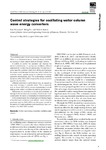Control strategies for oscillating water column wave energy converters
| dc.contributor.author | Freeman, K | |
| dc.contributor.author | Dai, Yong Ming | |
| dc.contributor.author | Sutton, R | |
| dc.date.accessioned | 2016-08-05T10:07:24Z | |
| dc.date.available | 2016-08-05T10:07:24Z | |
| dc.date.issued | 2014-03-01 | |
| dc.identifier.issn | 1756-0543 | |
| dc.identifier.issn | 1756-0551 | |
| dc.identifier.uri | http://hdl.handle.net/10026.1/5193 | |
| dc.description.abstract |
The oscillating water column wave energy converter (OWCWEC) is an established device which produces electricity by causing an ocean wave to drive air through a turbine. A system to control the operation can improve the device's performance. In varying sea conditions, different objectives for control may be appropriate. For example, in some seas the controller might shut off the plant because the waves could damage the structure, while in others the controller should operate purely to maximise the energy passed to the electricity grid. The fundamentally nonlinear dynamics of the OWC-WEC influence the choice of control algorithm for the WEC. Different outcomes in performance may be caused by very small changes in controller action. This is especially true for those OWC-WECs whose characteristics include stalling under certain conditions for optimal performance. Robustness to uncertainty in inputs and prevention of damage to the structure are necessary. However, too much conservatism will lead to unnecessarily low extracted powers. In the present paper, the advantages and disadvantages of feed-forward controllers and artificial neural networks previously used on OWC-WECs are discussed, as well as the testing of model predictive control and fuzzy logic controllers in the OWC-WEC context. | |
| dc.format.extent | 3-13 | |
| dc.language | en | |
| dc.language.iso | en | |
| dc.publisher | Society for Underwater Technology | |
| dc.subject | 7 Affordable and Clean Energy | |
| dc.title | Control strategies for oscillating water column wave energy converters | |
| dc.type | journal-article | |
| dc.type | Journal Article | |
| plymouth.issue | 1 | |
| plymouth.volume | 32 | |
| plymouth.publication-status | Published | |
| plymouth.journal | Underwater Technology: International Journal of the Society for Underwater | |
| dc.identifier.doi | 10.3723/ut.32.003 | |
| plymouth.organisational-group | /Plymouth | |
| plymouth.organisational-group | /Plymouth/Faculty of Science and Engineering | |
| plymouth.organisational-group | /Plymouth/Faculty of Science and Engineering/School of Engineering, Computing and Mathematics | |
| plymouth.organisational-group | /Plymouth/PRIMaRE Publications | |
| plymouth.organisational-group | /Plymouth/REF 2021 Researchers by UoA | |
| plymouth.organisational-group | /Plymouth/REF 2021 Researchers by UoA/UoA12 Engineering | |
| plymouth.organisational-group | /Plymouth/Research Groups | |
| plymouth.organisational-group | /Plymouth/Research Groups/Marine Institute | |
| plymouth.organisational-group | /Plymouth/Users by role | |
| plymouth.organisational-group | /Plymouth/Users by role/Academics | |
| dc.identifier.eissn | 1756-0551 | |
| dc.rights.embargoperiod | Not known | |
| rioxxterms.versionofrecord | 10.3723/ut.32.003 | |
| rioxxterms.licenseref.uri | http://www.rioxx.net/licenses/all-rights-reserved | |
| rioxxterms.type | Journal Article/Review |


